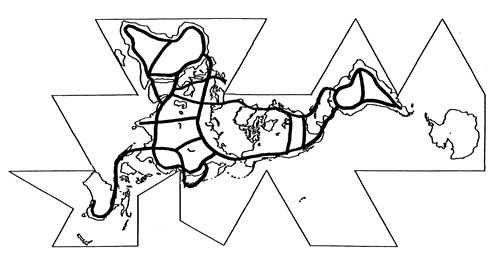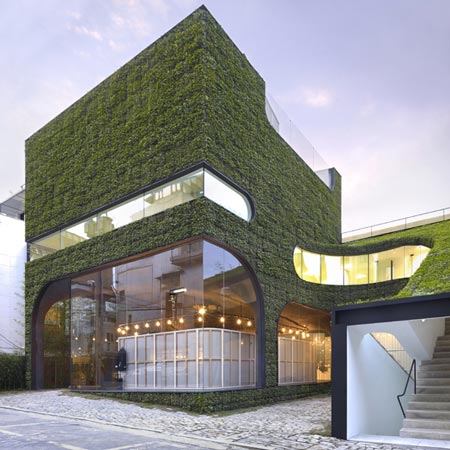As I mentioned in the recent reckoning of the L+U blog, I wanted to focus on a number of recent texts that I’ve had the chance to delve into (by disconnecting myself from the nefarious teat of the RSS feeder) Of significance is finally getting around to expanding on the initial readings of the book Ecological Urbanism (check out Intro by Mohsen Mostafavi, ‘Why Ecological Urbanism? Why Now?, in two parts here and here) which although gigantic, dense and brick-like, is also yielding some engaging content.
Thus in lieu of another option for a book with over 100+ essays and snippets from various authors, I’m going to chronologically post on each one on a mostly, time permitting, daily basis – in some cases just a fragment or two worthy of discussion – sometimes in more length. Hope you enjoy. Here’s the first installment – follow by regular installments with the moniker RBC.
________________________________________________________
Advancement versus Apocalypse | Rem Koolhaas
In this essay, which I gather is a short-form version of a presentation, Koolhaas provides a hybrid chronology of modern progress, focusing on “…the coexistence of modernity and endlessly improvised, spontaneous conditions that don’t consume much energy or material. For me, a hybrid condition is the condition of the day.” (56) Through searching history in the framework of ecological urbanism, he finds some precedents in the early indigenous knowledge of people, noting that over 2000 years ago, the basic tents of ecology were known, expressed in the vernacular, utilitarian architecture where people would “…build to be economical, logical, and beautiful.” (57) This concept and focus on the site and siting of cities was echoed in the Ten Books of Vitruvius, through the Renaissance, and to the Enlightenment, which.”...had a phenomenal effect on reason, in terms of triggering the apparatus of modernity in a surprisingly short time.” (58)
Thus along with the science and technology of modernity can the apocalyptic baggage best expressed by Malthus in the late 18th Century, and continued in more modern times through authors like Paul Ehrlich in the 1970s (Population Bomb) and even into today’s discussions of peak oil and environmental degredation, referenced by James Lovelock (The Revenge of Gaia).

:: Amazon Burning – image via expertsure
Koolhaas mentions an earlier formative experience with the ecological in the late 1960s, mentioning instructors working with tropical architecture that instilled a “respect for the landscape” and the ability to “look at other cities to see how they work , and to look at seemingly nonarchitectural environments.” (60) and expressed in attempts at the time to combine design and science such as Ian McHarg’s ‘Design with Nature’ referred to as “…one of the most subtle manifestos on how culture and nature could coexist.” (62)
Koolhaas expands this with a quote from Frederick Steiner in‘The Ghost of Ian McHarg:
“Almost 40 years ago, Ian McHarg proposed a bold theory and a set of ecologically related planning methods in Design with Nature (1969). While the proatical measures he proposed have been incorporated into subsequent design and planning practices, the theoretical implications have not yet been fully realized. Present-date forms of the model include the amalgam ‘landscape urbanism,’ with its focus on infrastructure an\d urban ecology, a hybrid discipline arguably indebted to McHarg while distinct in its avoidance of the more strenuous effects of his project.” (62)
In addition to McHarg the text mentions contemporary Buckminster Fuller’s focus on the “…combination of nature and network…” expressed in this network diagram of global high voltage transmission networks (62) and also the work of the Club of Rome – Limits to Growth in 1972 (strangely enough a notable reason in Jonathan Franzen’s recent book ‘Freedom’).

:: High Voltage Transmission Network diagram – image via GENI
The environmental intelligence of the 1970s was soon quashed by the market economy, as Koolhaas mentions, “…had a devastating effect on the knowledge that had accumulated at this point.” (65) The current situation of economics gain over ecological approaches has continued since the 1970s.
Shifting gears a bit, the current focus on ecological urbanism is the role of technology, specifically indicative of the engineering/technology will save us paradigm epitomized by Freeman Dyson – quoted in the NY Times: “…proposed that whatever inflammations that climate was experiencing might be a good thing because carbon dioxide helps plants of all kinds to grow. Then he added the caveat that if CO2 levels soared too high, they could be soothed by the mass cultivation of specially bred ‘carbon-eating trees’…” (66)
In addition to noting these radical technological fixes, Koolhaas also bemoans the current trend of boutique green-was expressed in the application of greenery to buildings, mentioning that, “Embarrassingly, we have been equating responsibility with literal greening.” (69), mentioning specifically the Ann Demeulemeester store in Seoul, the work of Ken Yeang and the recent Renzo Piano design for the California Academy of Sciences building as examples of this travesty of architecture.

:: Ann Demeulemeester Store in Seoul – image via Style Frizz
This confuses me, as while I am not as excited about the green application of vegetation, the inclusion of the specifically bioclimatic architecture of Yeang seems misplaced, as it seems an expression of ecological urbanism. Instead, Koolhaas finds merit in building new eco-cities in the desert, mentioning Norman Foster’s Masdar zero-carbon city as “serious”, and a step forward from the boutique natural interventions of Yeang and Piano, mentioning: “…we need to step out of this amalgamation of good intentions and branding in a political direction and a direction of engineering.” (70)
:: Masdar City – image via Menainfra
While a somewhat interesting exploration, it is somewhat circuitous and peppered with Koolhaas’ self-professed doubt in the overall project, mentioning in the intro “I did not assume that anyone in the academic world would ask a practicing architect in the twenty-first century, given the architecture that we collectively produce, to participate in a volume on ecological urbanism…” (56) This perhaps colors the text somewhat away from individual buildings and more towards the massive, techno-centric solutions from Koolhaas/OMA – such as the large-scale wind energy project in the North Sea mentioned in the end of the essay.
It’s obvious therein lies a distancing from the individual ecological building in the context of these bigger, more significant infrastructural interventions – which marks a distinction, notably with the architecture of Koolhaas being rigorously programmatic, urban-engaged, but typically non-ecological. Maybe the realization that one building here or there isn’t going to be the solution is valid and worthy of discussion? Is ecological urbanism about large-scale ecocities or infrastructure, or the aggregation of interventions at a variety of scales – maybe even including buildings?
(from Ecological Urbanism, Mostafavi & Doherty, eds. 2010, p.56-71)


I would like to think ecological urbanism is about about large-scale ecocities or infrastructure, or the aggregation of interventions at a variety of scales – maybe even including buildings
Yet I think his suggestion that it is really a more infrastructural or technocratic/regional/new city scale is a provocative one.While small scale change is good, how much is helped by boutique greening of the kind he specifically mentions.
Although, the Yeang inclusion does seem a bit out of place i think it fits in within a framework of arguing for large vs small (building) scales greening.